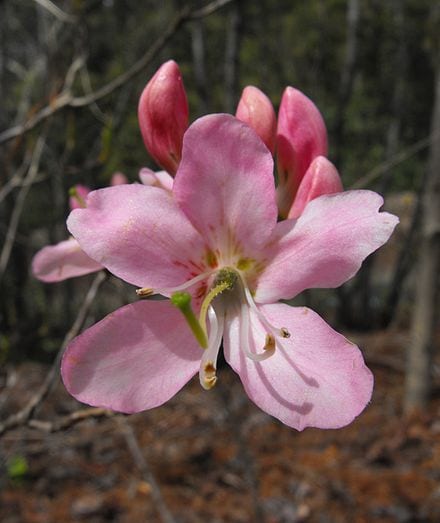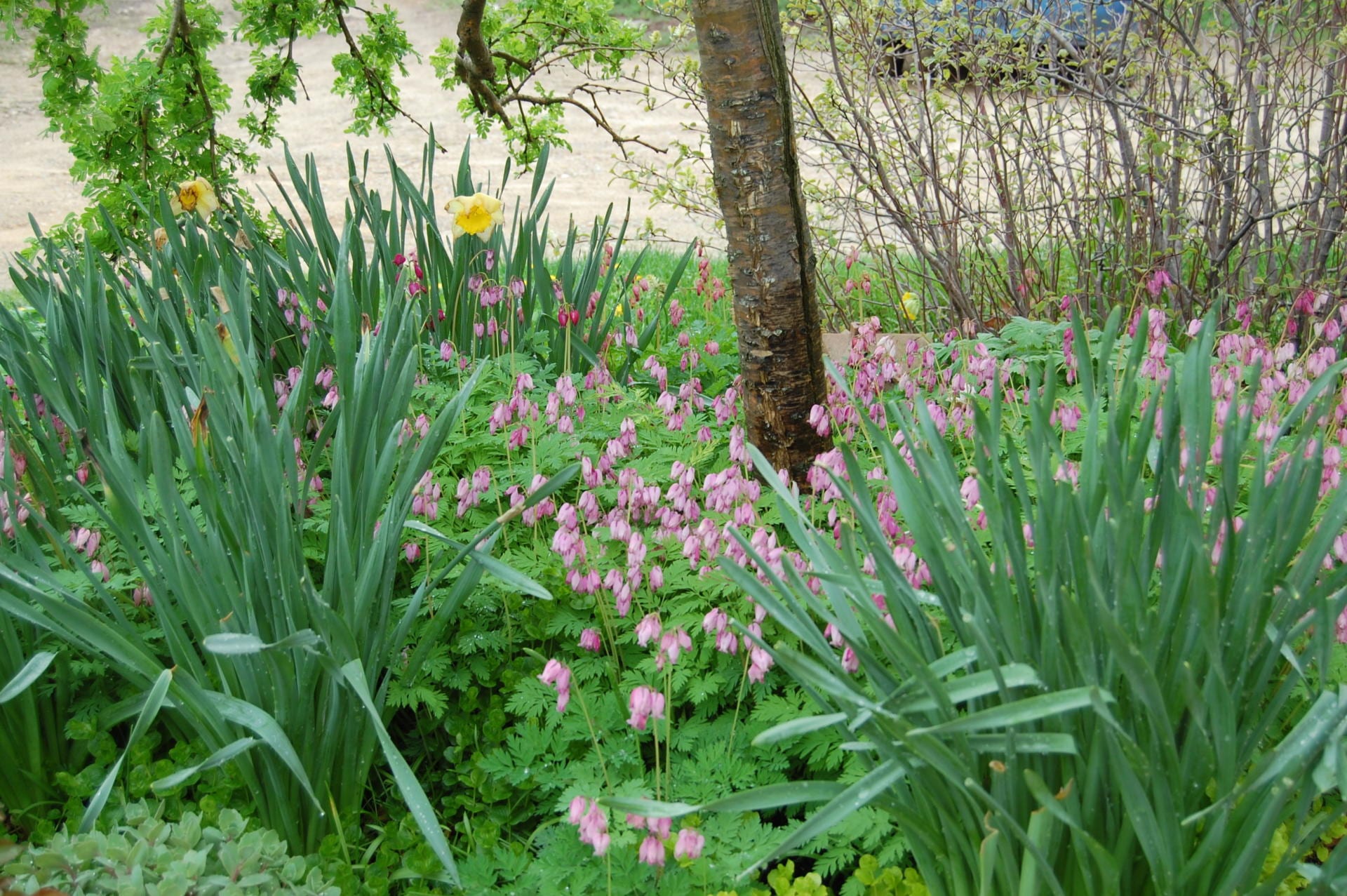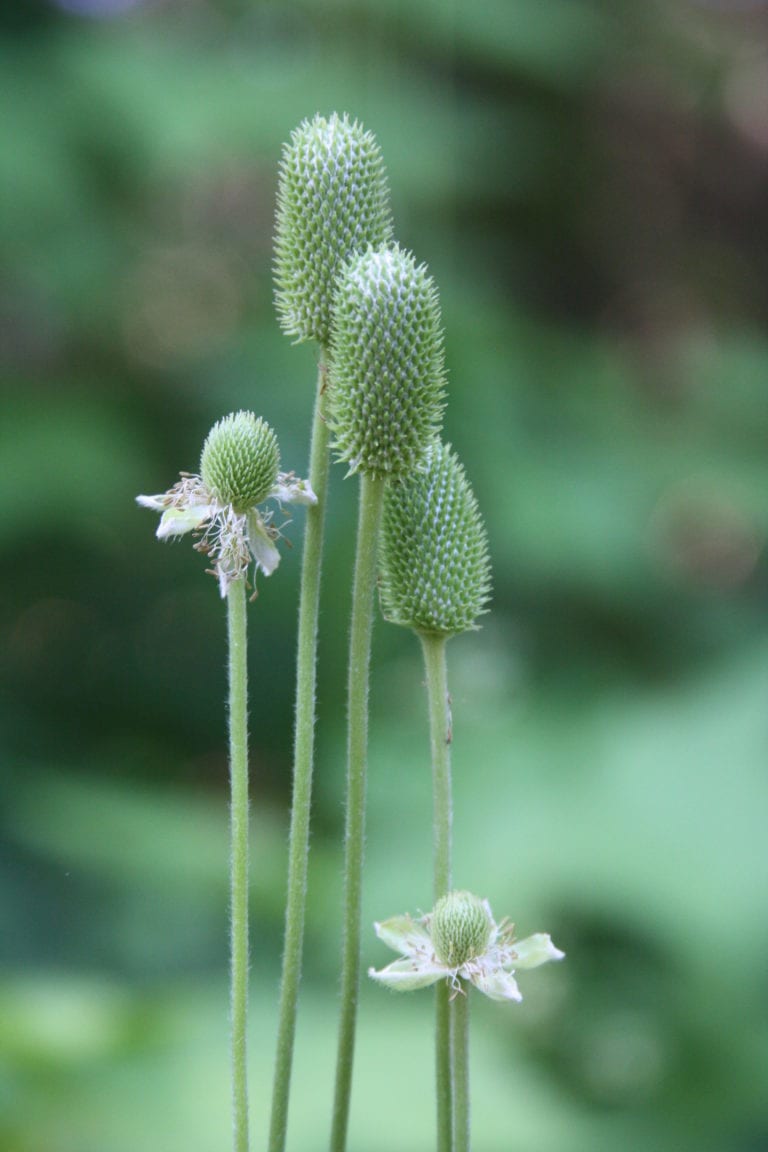I live in Washington DC (zone 7a) with a smallish back garden divided into two trapezoid beds – one on either side of a brick path. I have been trying to layer plants and have had some success; however, new neighbors have installed trees along one side of the fence that have cast one of the beds in full shade in the back along the fence line and partial shade in the front along the brick walkway. The sunny side is doing great and is planted with groundcover, plants, vines, and shrubs of various heights screening the 8-foot fence top, but after a year of the sun/part sun plants stuck in shade, the shady side has pretty much kicked the bucket. The thing is, I can’t figure out how to have a shade bed complement the sun bed directly across from it – it’s not that things have to be matchy-matchy, but the brickwork makes them a symmetrical pair of beds. I am having trouble finding shade plants that I can combine into an ecological design, except low groundcovers and short woodland plants, and I am having a hard time visualizing what would work right across the bed of climbing roses, lambs ears, baptisa, gaura, japanese anemones, euphorbia, and salvia. ANY suggestions would be so, so appreciated. I am completely stumped!
In selecting new plants for the shady bed, you might first think about the sizes, forms, leaf colors and textures of the plants in the sunny bed. Can you echo these features (using shade plants) in the shady bed? I agree that too matchy-matchy will look like a Victorian park, but as you point out, especially since you have the brick path running down the middle, a sense of balance from side to side will make things harmonious. So, where you have, say, a medium-size shrub cluster in the sunny bed, aim for a similar cluster (but a different plant variety, of course) in the shady bed on the other side…give or take one or two shrubs. Where you have silver-leaved groundcovers in the sunny bed, use a grouping of shade-loving silvery plants in the shade bed, but make the group a bit larger or smaller. The placement of the groupings from side to side doesn’t have to be exactly the same, but the plant massing should feel balanced. One thing I would not worry about echoing in the two beds is bloom colors and bloom times. The balanced structure of the beds will hold the garden visually together.
It is certainly a challenge to choose shade-loving plants that can produce the same effects as sun-loving ones, especially if you are aiming for an all-native plant list to encourage local pollinators and habitat. But it can be done! Below are some suggestions, going by your list of what is in your sunny bed. Since you indicate that you have groundcovers and short woodland plants already, I’ve listed mostly medium and tall shade perennials and small to medium shade shrubs. You’ll certainly want to keep the groundcovers running through it all, to knit the design together. It will be fun to experiment. You may find that after a few years, some plants will have given up, but you will be left with a strong core of shade plants that thrive in your specific garden. Note that in order to select the widest variety of natives for your garden, I have not restricted these suggestions to Washington, DC-area natives only. I’ve used the widest definition of “native” (native to North America); all are hardy in your zone.
Shade plants to match climbing roses
Climbing roses often have a medium to tall fan shaped form, with tall leaders arching up. Try the following slightly rangy, fan-shaped, up-reaching, flowering native shade shrubs.
Rhododendron vaseyi (pinkshell azalea) or Rhododendron viscosum (swamp azalea) – Rangy upright form and stays medium sized in shady habitat. Deep shade OK.
Ceanothus Americanus (New Jersey tea) – Stays 2-3 feet high if you need smaller shrub.
Clethra alnifolia ‘Ruby Spice’ (pink summersweet) – upright shrub with pink flowers midsummer if you want to match a pink rose. You will need to selectively prune every few years if it suckers or grows too tall. Medium shade OK.
Hydrangea quercifolia (oakleaf hydrangea) ‘Munchkin,’ Sikes Dwarf,’ or ‘Ruby Slippers’– Flowers in medium to deep shade in my experience.
Philadelphus lewisii (native mock orange) – Try ‘Cheyenne’. Our native Mock Orange is a western shrub, but the scent and small rose-like flowers are to die for! Will need selective pruning and sucker removal every few years. In my experience, blooms in medium shade.
Pieris floribunda (native andromeda) – It’s rangier and much more up-reaching than Japanese Andromeda. Evergreen. Very slow growing, so try to get 3-foot specimens. Deep shade OK.
Rosa palustris (swamp rose) – Can grow in garden soil and in my experience, blooms in medium shade.
Sambucus canadensis (American elderberry ‘Nova’ – A smaller variety, flowers in medium to deep shade in my experience.
Vaccinium corymbosum (highbush blueberry) – Naturally grows in fan-shaped form in understory woodland. Selectively prune if it gets too tall after several years.
It would be fun to try growing a clematis up through the shrubs, either against the wall or on a tuteur. I have a ‘Ramona’ that blooms repeatedly all summer in deep shade on the north foundation of my house. In lighter shade, you could try Lonicera sempervirens, a native honeysuckle vine.
Shade plants to match Lambs Ears
Athyrium felix-femina ‘Ghost’ (lady fern) – This is actually a hybrid so not straight native, but has nice silvery fronds.
Dicentra eximia (native bleeding heart – Persists all season. Glaucous leaves.
Heuchera Americana (native coral bells ‘Dale’s Strain’ – 12-18” high and large, silver-veined leaves.
Tiarella cordifolia (foamflower) ‘Mystic Mist’ – Has silvery leaves.
Shade plants to match Baptisia
Agastache foeniculum ‘Golden Jubilee’ (anise hyssop) – Flowers in medium shade in my experience.
Amsonia tabernaemontanta ‘Blue Ice’ (bluestar) – Flowers in medium to deep shade in my experience.
Delphinium exaltatum (tall larkspur) – For a lightly shady area; the bloom color matches Baptisia nicely.
Eurybia divaricata (white wood aster and Symphtrichum cordifolia (Blue Wood aster) – Maybe try the purple one to match the Baptisia?
Polygonatum commutatum (giant Solomon’s seal) – Although the flower color and structure are different from Baptisia, the height and plant mass are similar. This is an absolutely wonderful medium to deep shade forest plant that loves city gardens!
Shade plants to match Gaura
Actaea racemosa (black cohosh) – Try ‘Brunette’
Gillenia trifoliata (bowman’s root) – Known as “the gaura for shade”!
Chelone glabra (white turtlehead) – Will grow in normal garden soil, medium to light shade. There is a pink variety also.
Penstemon digitalis (foxglove beardtongue) – Flowers in medium to light shade
Shade plants to match Japanese Anemones
Actaea rubrifolia (Appalachian bugbane) – Tall with maple-like basal leaves. Endangered in the wild, but available from Van Berkum Nursery.
Anemone virginiana (tall thimbleweed) – Light to medium shade; needs consistent moisture.
Aruncus dioicus (goatsbeard ) – Choose the smaller (relatively) ‘Kneifii.’ Although the blooms are quite different from anemone, the height and bulk are similar. Needs consistent moisture.
Shade plants to match Euphorbia
There is a native woodland spurge, Euphorbia commutata, that is an attractive wild plant. It is not available as a nursery plant, however.
Aquilegia canadensis (native columbine) the red and yellow colors of the flowers and blueish leaves match colorful garden spurges.
Heuchera spp. (coral bells) and Heucherella (heuchera-tiarella hybrid) – There are many heucheras and heucherallas (all of which are native to North America) that have brightly colored leaves similar to euphorbia colors.
Tiarella spp. (foamflowers) – There are many tiarellas (all of which are native to North America) that have brightly colored leaves similar to euphorbia colors.
Shade plants to match Salvia
Lobelia cardinalis (cardinal flower) – Purple varieties exist: ‘La Fresco’ is a cross between the natives cardinalis and siphilitica, as is ‘Grape Knee-High.’ Or go with the beautiful scarlet native! They grow fine in regular garden soil and shade.
Or use any of the matches for Baptisia listed above.
~Amanda Sloan, RLA, Raingarden Design Studio, Sharon, MA
ELA members have spent hundreds of hours learning the best ecological solutions to problems in the landscape. You can benefit from all that accumulated knowledge by posing a question to our experts. If you are stumped by a problem in your landscape or are looking for a second opinion on a potential solution, ask ELA’s Eco-Pros. Send your question to ela_new@verizon.net. And if you need additional help, refer to the listing of ELA Professionals.
***
Each author appearing herein retains original copyright. Right to reproduce or disseminate all material herein, including to Columbia University Library’s CAUSEWAY Project, is otherwise reserved by ELA. Please contact ELA for permission to reprint.
Mention of products is not intended to constitute endorsement. Opinions expressed in this newsletter article do not necessarily represent those of ELA’s directors, staff, or members.






